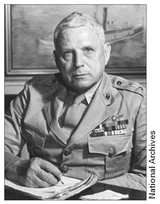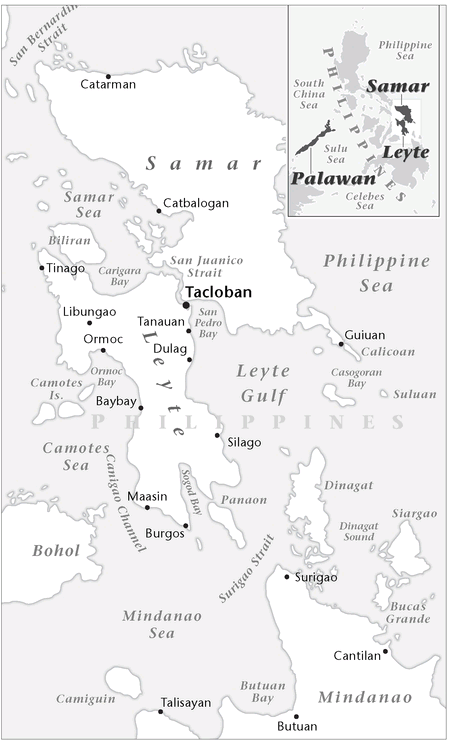War Stories II (55 page)
Authors: Oliver L. North

 OPERATION STALEMATE
OPERATION STALEMATE1ST MARINE DIVISION
PELELIU, PALAU ISLANDS
28 SEPTEMBER 1944
PELELIU, PALAU ISLANDS
28 SEPTEMBER 1944
After Peleliu's airstrip was under American control, Marine Corsairs began to use the field. The aircraft would take off, bomb, strafe, or drop napalm and land again all in the space of five minutes. Many times the pilots wouldn't even bother to raise their landing gear.
After a week of furious battle, General Roy Geiger came ashore to assess the situation. By the time the amphibious assault force commander made his visit to Peleliu, Puller's 1st Marines had taken 2,300 casualties. Despite Puller's objections, Geiger decided that the depleted regiment had to be pulled off of the island. The 1st Battalion had suffered a horrific 70 percent dead or wounded. Ray Davis, its commander, would be awarded the Navy Cross.
General Geiger replaced the 1st Marines with a regimental combat team from the U.S. Army's 81st Infantry Division, the “Wildcats,” at the end of that terrible first week. Using bazookas, tanks, and flame-throwers, the fresh troops broke the back of the Japanese defenses, though organized resistance didn't end until 13 October.
After seventy-two grueling days, the 5th and 7th Marine Regiments were finally withdrawn and rejoined the 1st Marines on Pavuvu.
Before committing ritual suicide at the end of October, Colonel Nakagawa sent a final message for Tokyo: “CHERRY BLOSSOM. CHERRY BLOSSOM. CHERRY BLOSSOM.” The meaning: “Peleliu has fallen.”
The victory had come at a ghastly cost. Nearly 600 soldiers, sailors, and Marines received awards for heroism. But the 1st Marine Division suffered a total of 6,500 casualties and the Army lost another 3,000. And for the Japanese it was even worse. Of the 10,000 troops of the original garrison, fewer than a hundred were alive at the end. In April of 1947, two and a half years after the battle for Peleliu ended, thirty-four Japanese soldiers surrendered. They still couldn't believe that the war was over.
Decades after the Battle of Peleliu, debate continues as to whether the United States really needed to fight the Japanese for the island. There are those who hold to the original premise that an unsecured Peleliu was a threat to MacArthur's flank and would have made the Allied thrust northward to Japan vulnerable.
Others think it wasn't necessary. They believe that the U.S. had already driven the Japanese fleet from the island waters and that any air threat from Peleliu could have been ameliorated by regular bombing of the airfield. According to this argument, the 10,000 Japanese troops on Peleliu were no more of a threat than the 120,000 isolated Japanese troops rotting at Rabaul.
Â
Major General Roy Geiger

Peleliu is sometimes called the “forgotten” battle of the Pacific war. But for those who fought there, it will always be remembered. Certainly no one questions the courage and determination of the Marines, soldiers, sailors, airmen, and Coast Guardsmen who fought in this battle and eventually seized this Japanese fortress. One Marine said it best about the bitter struggle: “All gave some; some gave all.”

CHAPTER 14
“I HAVE RETURNED”: THE BATTLE OF LEYTE
(OCTOBER 1944)
 U.S. 7TH FLEET
U.S. 7TH FLEETVICINITY SURIGAO STRAIT
NEAR THE PHILIPPINE ISLANDS
15 OCTOBER 1944
NEAR THE PHILIPPINE ISLANDS
15 OCTOBER 1944
T
he carnage in the Palau Islands did little to alter the short-term war plans for either the U.S. or Japan. Both sides were now locked into a bloody fight to the finish. For Tokyo there was only one choice: inflict as many casualties as possible on the Americans in hopes that the bloodletting might cause FDR to accept something less than unconditional surrender. It was a battle plan of utter desperation.
he carnage in the Palau Islands did little to alter the short-term war plans for either the U.S. or Japan. Both sides were now locked into a bloody fight to the finish. For Tokyo there was only one choice: inflict as many casualties as possible on the Americans in hopes that the bloodletting might cause FDR to accept something less than unconditional surrender. It was a battle plan of utter desperation.
In Washington, the costly battles for Tarawa and Saipan had already tempered any pretense of euphoria. Now, the Peleliu casualty figures were cause for the Joint Chiefs to contemplate the long-range consequences of invading the Home Islands. To the small handful who were aware of its potential, Peleliu was a good reason to consider the as yet untested atomic bomb as a preferable alternative to assaulting the emperor's native soil.
But all that was well into the future. In the near term, no one was prepared to suggest that MacArthur revise his plans for returning to the Philippines. Even before the fighting was done on Peleliu, Nimitz began shifting his subs, carriers, and surface forces south from the central Pacific to support the invasion of Leyte.
In preparation for the operation, code-named King Two, American bombers struck Imperial air and naval bases on Formosa and Luzon repeatedly in order to minimize the effectiveness of any counter-attack against MacArthur's invasion forces. By 11 October, when the ships of the 3rd Amphibious Force were ordered to sortie from the Admiralty Islands, the Japanese had lost air superiority over much of the southern Philippines. Two days later, the 7th Amphibious Force deployed from bases MacArthur had seized on the north coast of New Guinea.
On 15 October, the two amphibious forces rendezvoused with the rest of the 3rd and 7th Fleets, just east of Leyte, at the north end of the Surigao Strait. The combined 738-ship armada included eight large aircraft carriers, twenty-four small carriers, a dozen battleships, two dozen cruisers, and 141 destroyersâmaking it the most powerful naval force ever assembled.
Among those engaged in this extraordinary endeavor were some of the most famous names in the history of the U.S. Navy: Admiral “Bull” Halsey, commanding an abbreviated 3rd Fleet aboard the battleship
New Jersey
; Admiral Marc Mitscher, on the carrier USS
Lexington
; Rear Admirals Frederick Sherman, Ralph Davison, and Gerald Bogan; and Vice Admiral John S. McCain, the grandfather of Senator John McCain.
New Jersey
; Admiral Marc Mitscher, on the carrier USS
Lexington
; Rear Admirals Frederick Sherman, Ralph Davison, and Gerald Bogan; and Vice Admiral John S. McCain, the grandfather of Senator John McCain.
Vice Admiral Thomas Kinkaid, commander of the 7th Fleet, was also designated as the overall commander of the invasion operation. MacArthur, deployed aboard the cruiser
Nashville
, was little more than a passenger until he got ashoreâas he clearly intended to do as soon as possible. Halsey's 3rd Fleet, though not under Kinkaid's operational control, was nonetheless assigned the mission of providing cover for Kinkaid's 7th Fleet and the landings by the amphibious forces. It was a command arrangement that would come to haunt the invaders.
Nashville
, was little more than a passenger until he got ashoreâas he clearly intended to do as soon as possible. Halsey's 3rd Fleet, though not under Kinkaid's operational control, was nonetheless assigned the mission of providing cover for Kinkaid's 7th Fleet and the landings by the amphibious forces. It was a command arrangement that would come to haunt the invaders.
 HQ 6TH RANGERS ASSAULT
HQ 6TH RANGERS ASSAULTSULUAN AND DINAGAT ISLANDS
PHILIPPINE ISLANDS
18 OCTOBER 1944
PHILIPPINE ISLANDS
18 OCTOBER 1944
Though D-Day for the invasion of Leyte had been set by the Joint Chiefs for 20 October, operations ashore actually commenced on 17 October when the 6th U.S. Army Ranger Battalion, commanded by Lieutenant Colonel Henry “Hank” Mucci, charged ashore on the islands of Suluan and Dinagat. Their mission: destroy the Japanese radar and communications facilities and anti-shipping artillery on the tiny spots of land that provided natural obstacles off Leyte's landing beaches.
Supported by carrier air strikes and naval gunfire, Mucci's 500 Rangers made short work of the Japanese garrisons on both islands. On Dinagat, in a fashion reminiscent of Peleliu, the enemy had installed heavy artillery that could roll out of caves and fire at the approaching U.S. Navy ships. The guns were spiked in short order and despite lingering Japanese resistance, the Rangers set up beacons to guide the ships of the main landing force to their beaches. After securing the islands, the Rangers planted an American flagâthe first to fly in the Philippines since Japan had taken the islands from the United States almost three years earlier.
 ABOARD USS NASHVILLE
ABOARD USS NASHVILLELEYTE GULF
PHILIPPINE ISLANDS
20 OCTOBER 1944
PHILIPPINE ISLANDS
20 OCTOBER 1944
For the next forty-eight hours after Mucci's rangers seized the two little sentinel islands off Leyte, the landing beaches were pounded by the 7th Fleet's battleships. Carrier aircraft bombed and strafed the beaches. Employing lessons learned from the assaults on the Marianas and Palau Islands, naval gunfire spotters in small aircraft overhead and aboard close-in destroyers
and LCIs adjusted the fire of the battleships and cruisers until they were sure that every known target ashore had been hit at least four times.
and LCIs adjusted the fire of the battleships and cruisers until they were sure that every known target ashore had been hit at least four times.
Other books
Religious Love by Horton, T.P.
An American Outlaw by John Stonehouse
The Lover by Genell Dellin
Overkill by Robert Buettner
Claimed by the Wolf Billionaire (BBW Paranormal Alpha Romance) by Clarissa Black
The Teacher's Tales of Terror by Chris Priestley
Crash by Jerry Spinelli
White Christmas (novella) by Baxter, Ros
Royal Digs by Scott, D. D.
Second Chance by Linda Kepner
